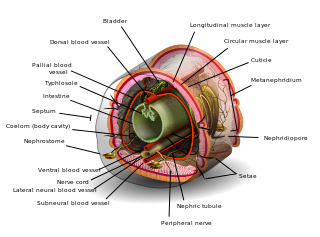
The coelom is the main body cavity in most animals and is positioned inside the body to surround and contain the digestive tract and other organs. In some animals, it is lined with mesothelium. In other animals, such as molluscs, it remains undifferentiated. In the past, and for practical purposes, coelom characteristics have been used to classify bilaterian animal phyla into informal groups.
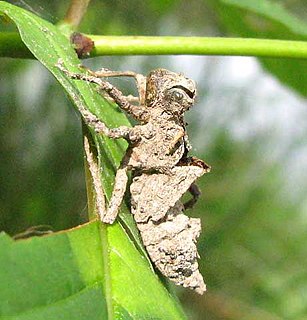
An exoskeleton is the external skeleton that supports and protects an animal's body, in contrast to the internal skeleton (endoskeleton) of, for example, a human. In usage, some of the larger kinds of exoskeletons are known as "shells". Examples of animals with exoskeletons include insects such as grasshoppers and cockroaches, and crustaceans such as crabs and lobsters, as well as the shells of certain sponges and the various groups of shelled molluscs, including those of snails, clams, tusk shells, chitons and nautilus. Some animals, such as the tortoise and turtle, have both an endoskeleton and an exoskeleton.

The gastropods, commonly known as snails and slugs, belong to a large taxonomic class of invertebrates within the phylum Mollusca called Gastropoda.
The radula is an anatomical structure used by mollusks for feeding, sometimes compared to a tongue. It is a minutely toothed, chitinous ribbon, which is typically used for scraping or cutting food before the food enters the esophagus. The radula is unique to the molluscs, and is found in every class of mollusc except the bivalves, which instead use cilia, waving filaments that bring minute organisms to the mouth.

Monoplacophora, meaning "bearing one plate", is a polyphyletic superclass of molluscs with a cap-like shell now living at the bottom of the deep sea. Extant representatives were not recognized as such until 1952; previously they were known only from the fossil record, and were thought to have become extinct over 380 million years ago.

Sea slug is a common name for some marine invertebrates with varying levels of resemblance to terrestrial slugs. Most creatures known as sea slugs are actually gastropods, i.e. they are sea snails that over evolutionary time have either completely lost their shells, or have seemingly lost their shells due to having a greatly reduced or internal shell. The name "sea slug" is most often applied to nudibranchs, as well as to a paraphyletic set of other marine gastropods without obvious shells.

A siphon is an anatomical structure which is part of the body of aquatic molluscs in three classes: Gastropoda, Bivalvia and Cephalopoda.

The mantle is a significant part of the anatomy of molluscs: it is the dorsal body wall which covers the visceral mass and usually protrudes in the form of flaps well beyond the visceral mass itself.
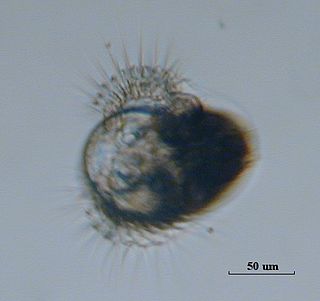
A veliger is the planktonic larva of many kinds of sea snails and freshwater snails, as well as most bivalve molluscs (clams) and tusk shells.

Limpets are a group of aquatic snails that exhibit a conical shell shape (patelliform) and a strong, muscular foot. Limpets are members of the class Gastropoda, but are polyphyletic, meaning the various groups called "limpets" descended independently from different ancestral gastropods. This general category of conical shell is known as "patelliform" (dish-shaped). All members of the large and ancient marine clade Patellogastropoda are limpets. Within that clade, the members of the Patellidae family in particular are often referred to as "true limpets".
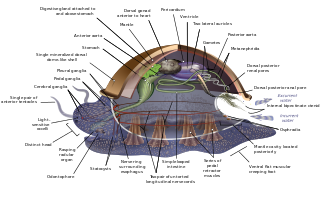
The evolution of the molluscs is the way in which the Mollusca, one of the largest groups of invertebrate animals, evolved. This phylum includes gastropods, bivalves, scaphopods, cephalopods, and several other groups. The fossil record of mollusks is relatively complete, and they are well represented in most fossil-bearing marine strata. Very early organisms which have dubiously been compared to molluscs include Kimberella and Odontogriphus.
Torsion is a gastropod synapomorphy which occurs in all gastropods during larval development. Torsion is the rotation of the visceral mass, mantle, and shell 180˚ with respect to the head and foot of the gastropod. This rotation brings the mantle cavity and the anus to an anterior position above the head.

The subcommissural organ (SCO) is one of the circumventricular organs of the brain. It is a small glandular structure that is located in the posterior region of the third ventricle, near the entrance of the cerebral aqueduct.

The molluscshell is typically a calcareous exoskeleton which encloses, supports and protects the soft parts of an animal in the phylum Mollusca, which includes snails, clams, tusk shells, and several other classes. Not all shelled molluscs live in the sea; many live on the land and in freshwater.
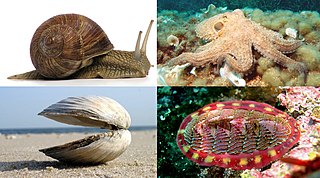
Mollusca is the second-largest phylum of invertebrate animals after the Arthropoda. The members are known as molluscs or mollusks. Around 85,000 extant species of molluscs are recognized. The number of fossil species is estimated between 60,000 and 100,000 additional species. The proportion of undescribed species is very high. Many taxa remain poorly studied.
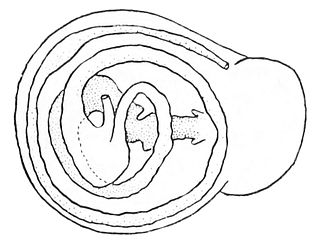
The digestive system of gastropods has evolved to suit almost every kind of diet and feeding behavior. Gastropods as the largest taxonomic class of the mollusca are very diverse: the group includes carnivores, herbivores, scavengers, filter feeders, and even parasites.

The nervous system of gastropods consists of a series of paired ganglia connected by major nerve cords, and a number of smaller branching nerves. It is sometimes called ganglionic.

Streptoneury or chiastoneury is a plesiomorphic condition present in all gastropods which is a result of an evolutionary event called torsion in which the intestines, heart, nephridia, gills, and nerve cords "twist" causing some organs to migrate from the animal's left to its right in order to accommodate the relocation of the mantle cavity close to the animal's head. Specifically, streptoneury is the crossing of the cerebrovisceral connectives caused by this torsion.
Bathyacmaea secunda is a species of very small, deep-sea limpet, a marine gastropod mollusk in the family Pectinodontidae. This species inhabits the dark, chemosynthesis-based marine communities of ocean vents and cold seeps near Japan.

A circumesophageal or circumpharyngeal nerve ring is an arrangement of nerve ganglia around the esophagus/ pharynx of an animal. It is a common feature of nematodes, molluscs, and many other invertebrate animals, though it is absent in all vertebrate animals and is not structurally possible in simpler ones such as water bears.
















